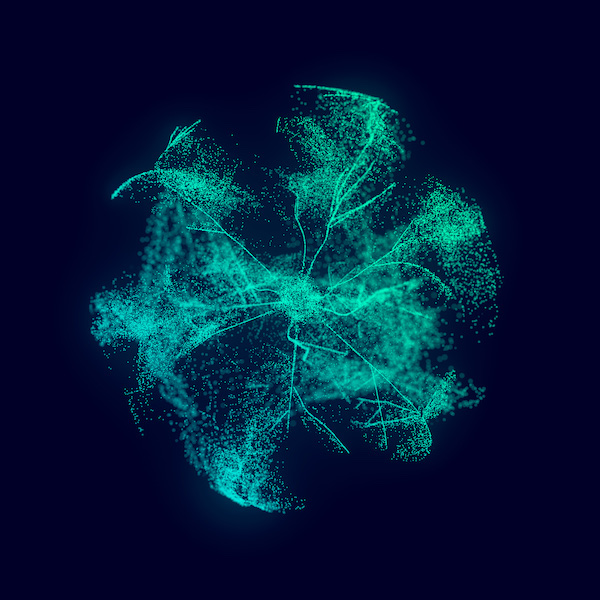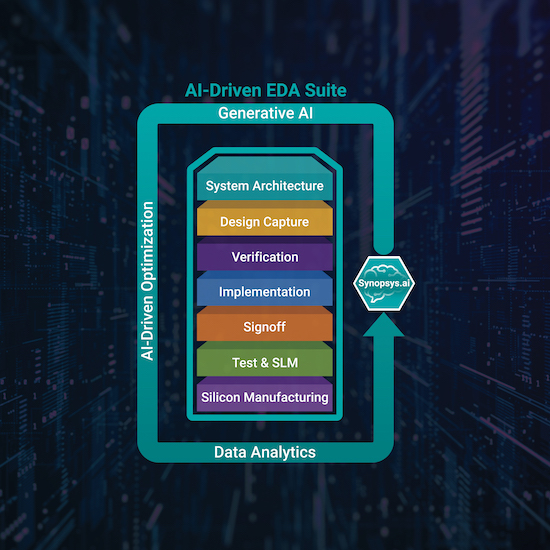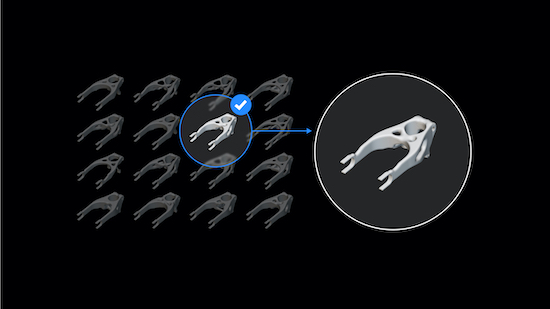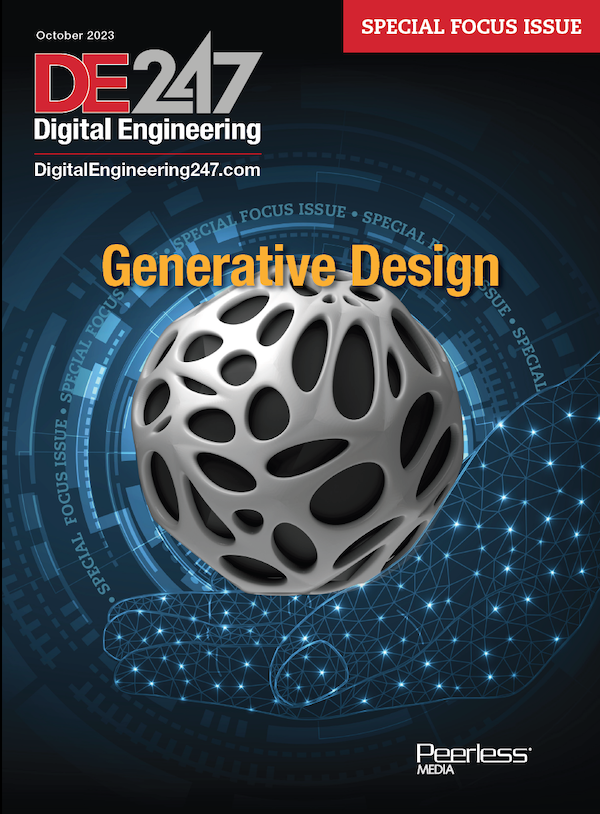
Fig. 1: AI–assisted design tools like Point-E, a machine learning system that creates a 3D model when given a text prompt, have attracted the attention of product development teams. Point-E generates discrete sets of data points in space that represent a 3D shape. Image courtesy of Siemens Digital Industries Software.
Latest News
November 20, 2023
For some, the mere mention of artificial intelligence (AI) conjures up images of systems like HAL 9000 or Skynet subjugating the human race. These attitudes have created an atmosphere in which many fear the development and use of any form of AI technology. Given this trepidation and the growing presence of AI in the design and development sector, it may not be too farfetched for design engineers to wonder if they will ultimately be replaced by a collection of powerful algorithms.
Design tool developers that have begun to harness the power of AI, however, are quick to answer this question with a resounding “NO!” In fact, these companies take the discussion one step further, asserting that the incorporation of AI in design tools benefits the engineer and plays to the human strengths.
“The human factor will always be necessary for complex problem-solving, ethical and moral considerations, interdisciplinary collaboration and design customization,” says Dale Tutt, vice president of industry strategy at Siemens Digital Industries Software. “AI is a design assistant, not a design engineer. The future of design is likely to involve a symbiotic relationship between human designers and AI tools, where AI enhances efficiency, provides insights and handles mundane computational tasks, while human designers bring creativity, ethical judgment and the ability to navigate the complex and ever-evolving landscape of design challenges” (Fig. 1).
This human-machine dynamic will also validate the importance of the engineer’s creativity and innovation.
“Human creativity could very well be the big winner in all of this,” says Arvind Narayanan, senior director of product line management, EDA Group, at Synopsys. “For example, in chip design, there are time-consuming tasks that are iterative, yet paramount for achieving best quality of results. AI technologies cannot only take on these tasks to improve productivity but can also explore the solution space to deliver better quality of results. This frees up time for experts to focus on value-added tasks, such as differentiating their products and quickly creating new features or derivative designs.”

Fig. 2: Today, AI can automate electronic design automation (EDA) software functions such as system architecture, design, testing, and silicon lifecycle management. It can also support conversational intelligence via generative AI capabilities to work alongside designers across EDA tools. Image courtesy of Synopsys.
It’s important to remember that AI is only as powerful as the humans that create and train the algorithms. Well-sculpted AI-assisted design tools benefit from the engineer’s design experiences, leveraging lessons gained from one project by applying them in future projects.
“The model itself is only a part of the equation when it comes to the value of AI,” says Todd McDevitt, director of product technology at nTop. “An AI assistant is only as sophisticated as the data that it trains on. As these models incorporate more data—especially more complex data—they will be able to help find more innovative solutions for increasingly complicated problems. Moreover, the AI-assistant still requires input from the engineer to produce the end design.”
To appreciate the full potential of AI, it helps to examine the state of the technology today, weighing its evolving forms, capabilities, challenges and benefits—ultimately piecing together a view of the future.
Evolving Nature of Design AI
At this point in AI’s evolution, the technology has taken on several different forms when applied to the engineering design process. Among these forms are traditional AI systems and an emerging technology called generative AI.
Traditional AI systems typically respond to specific inputs and focus on performing a predetermined task. These systems can analyze and learn from data, excel at pattern recognition and make decisions or predictions. Traditional AI systems, however, do not create new content.
An example of a traditional AI system is Google’s search algorithm. This model has been trained to follow well-defined rules and perform specific functions.
On the other hand, generative AI can create new content, which can range from text, images and music to computer code and even virtual environments.
Generative AI uses several techniques, foremost of which are large language models (LLMs). These neural networks are the algorithmic basis for chatbots, and they are frequently trained with unlabeled or uncategorized text and use self-supervised or semisupervised learning methodologies.
The LLM takes the training data, identifies and learns the underlying patterns, and then generates new elements that mirror the training set. LLMs essentially are prediction engines.
These models are incredibly complex, controlled by vast numbers of parameters. For example, the nonprofit AI research laboratory OpenAI that created ChatGPT is purported to have used 1 trillion parameters in its GPT-4 LLM. Consequently, these models require complex math and significant computing power.
Currently, generative AI commonly uses natural language commands to create content. This obviates the need for any coding knowledge.
Adding Natural Language Processing
This newer technology is still very much in its early days, with the developers of generative AI–assisted design tools constantly redefining and expanding the roles played by their systems.
An example of this can be seen in OpenAI’s ChatGPT. This chatbot generative pretrained transformer is based on the GPT LLM, an algorithm that processes natural language inputs and predicts the next word based on previously learned data.
“ChatGPT harnesses AI to create new content such as text, images, and videos based on large language models that have been trained,” says Narayanan. “ [Electronic design automation (EDA)] tools, such as the Synopsys.ai Copilot, are capable today of using generative AI technology to help boost productivity of the semiconductor design flow.. Gen AI applications, such as the Synopsys.ai Copilot, can help address expert queries and provide results and works flows that help designers in closing their designs faster.”
A few generative AI–based text-to-image tools in particular have attracted the attention of design engineers, such as Point-E, a machine learning system that creates a 3D model when given a text prompt.
Point-E does not create 3D models in the traditional sense. Instead, it generates point clouds—discrete sets of data points in space that represent a 3D shape. Point clouds are easier to synthesize from a computational standpoint, but they don’t deliver high-resolution shapes and textures.
“Tools like Point-E show the promise of the technology, but the engineering use cases we’ve seen are limited,” says McDevitt. “The challenge with developing AI-enabled 3D engineering design is the availability of large data sets that have been tagged with ground truth. The success of today’s existing generative AI tools for audio, code, images and text has been largely due to the availability of large data sets.”
What AI Can Do for You
With the various AI technologies entering the product design and development arena, how can companies use AI, and how will the technology enhance the creation and refinement efforts to bring new and upgraded offerings to market?
In answer to these questions, design-tool developers point to a number of opportunities where they see the potential for AI to make improvements.
“It is within reason to speculate that AI-assisted design tools will play an increasingly stronger roll over the next five years, especially in areas like advanced generative design, enhanced simulation and testing, cognitive assistance for creatively, real-time collaboration and feedback, and AI-generated prototyping and fabrication,” says Tutt. “We will also see a much more seamless integration of AI and human expertise, especially as trust grows in the use of AI for these functions.”
On a more granular level, even at the early stages of its development, there is a robust variety of ways in which AI can be applied to product development.
For example, text-to-3D object tools can create designs from a command like, “Create a bracket.” This capability provides a starting point for a design and eliminates the tedious steps involved in creating the initial design.
“That time savings can be used to iterate designs more quickly,” says McDevitt. “These tools can also be used to add common features to designs—such as fillets—and save design teams the tiresome work of creating these features.”
AI can also be used to enhance simulations, greatly reducing the time required to evaluate design decisions. This can be accomplished by using trained physics models. These devices are reduced-order AI/ML models that run quickly for a limited range of boundary conditions. In doing so, they can reduce simulation times from hours (or even days) to seconds, allowing engineers to efficiently evaluate how a design change impacts the performance of a part.
A third example of how AI can enhance design and development efforts involves the use of a machine learning technique called physics-informed neural networks (PINN). This approach can be used to solve partial differential equations (PDEs), which play a crucial role in fluid dynamics and acoustic and structural engineering.
PINNs are considered to be a promising alternative to finite element modeling (FEM) methods, which can run into difficulties in leveraging external data sources. PINNs differ significantly from standard supervised ML in that, instead of relying solely on data, these neural networks use the physical properties of the PDE in the training process. To reduce the time to train the network, engineers can add known data points on top of the physics-based loss function.
Although PINNs also have drawbacks, they appear to have the potential to provide valuable insights. “Although the precision of this approach hasn’t been proven out to validate an engineering design, they can be sufficient to provide design direction,” says McDevitt.
While these AI techniques hold real promise for product development teams, the most immediate—and perhaps the greatest—value that AI-assisted design tools bring to the table is the automation of design, testing and validation (Fig. 2).
AI’s Sweet Spot
The potential benefits of using AI to automate design processes have not escaped early adopters. In fact, AI has already automated many processes and procedures in the background. As the technology evolves, industry experts believe that AI will become embedded in solutions in such a way that users will not even be aware of its presence.
“Automation will be key to the value that AI brings to engineering,” says Tutt. “As we move into the future, the work done to create traceable links from requirements through design and into the verification will be automated through AI, and when a product with many features is being developed, AI will be able to automatically start adding those features. As AI technologies continue to advance, we expect even more sophisticated automation of the design process.”
AI’s greatest current impact is mundane task automation. In applying AI in these situations, companies have been able to reduce repetitive or otherwise non-value-added tasks associated with simulation-driven design. The ability of AI-assisted design tools to learn from past designs and adapt to evolving requirements will further streamline and enhance the efficiency of the design process.
Generative design is one AI technique that has proven to be particularly useful in this area. It is a process that frees engineers from rote, repetitive work and mitigates many of the time and budgetary constraints that up until now have hindered design optimization.
Using this technique, the design engineer begins with an initial best guess and then refines it by iteratively evaluating various design options, using AI-enhanced simulation and engineering analysis.
Before the introduction of generative design, the time and cost of each iteration limited design engineers to exploring only a few of the possible options within a limited timeframe. As a result, final designs often fell short of their potential.
With the introduction of generative design, engineers can explore a broader set of design options, achieve greater optimization and more quickly identify solutions that best meet the configuration and product requirements of the part or product in question (Fig. 3).

Today, generative design allows development teams to perform simulation and analysis so quickly that they can evaluate designs in minutes or seconds. Furthermore, AI can automatically adjust variables of a design between simulations, without manual intervention. These capabilities allow development teams to explore a much larger collection of potential design approaches, in the process comparing the results of thousands of simulations to identify optimal designs.
“We already know there are many design alternatives to most problems, so enumerating a few doesn’t effectively move the design process forward,” says Joe Pajot, director of engineering data science at Altair. “AI-powered design tools enable designers to home in on high-performing designs quickly.”
Just Getting Started
It is no surprise that companies contemplating adoption of AI-assisted design tools face significant challenges, given that the technology is still in its early days in this sector. These hurdles fall into two general categories: data and infrastructure.
“The required training data is rarely readily available, which means that collecting and maintaining the necessary data sets will be a non-trivial task,” says Pajot. “Data management challenges will require focus on narrowly defined applications, where the value add is clear for all stakeholders. For every initiative, organizations will have to work through the questions: What does the AI do? What data will it need? How do we collect that data? How do we maintain that data?”
The challenges are particularly apparent in the electronics and design sector, where much work is being done to harness the power of AI in design processes.
“The EDA industry doesn’t have an unlimited amount of data to train LLMs today, and the quality of existing data is also crucial in improving the accuracy of the output,” says Narayanan. “Leveraging reinforcement learning using actual designs, however, helps to mitigate this challenge for now but having the infrastructure and data pipeline is important for proliferation of GenAI technologies.”
In terms of infrastructure shortfalls, the issues revolve around computing resources and legacy systems’ capacity for change.
“Compute requirements for AI are growing exponentially, and AI engines must become more efficient in reducing the compute profile without compromising the quality of results,” says Narayanan.
Unfortunately, the painful fact is that currently only large companies with deep pockets can afford the computing resources required to support many AI applications.
Over the next five years, companies’ primary focus will be to overcome these challenges. Don’t look for major changes in the human-machine dynamic.
“While some actions can be performed by AI in product design, we are, collectively, quite early in the journey,” says Pajot. “Fully automatic AI design remains a bit over the horizon. AI tools will play an expanding role, but narrowly focusing on applications that both reduce tedious work and allow humans to focus on high-value activity.”
Tom Kevan is a freelance writer/editor specializing in engineering and communications technology. Contact him via [email protected].
More Altair Coverage
More Siemens Digital Industries Software Coverage
More Synopsys Coverage
Subscribe to our FREE magazine, FREE email newsletters or both!
Latest News






